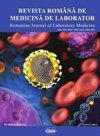Lupus anticoagulant in children – a confounding factor in diagnosis and targeted therapy
IF 0.5
4区 医学
Q4 MEDICINE, RESEARCH & EXPERIMENTAL
引用次数: 0
Abstract
Abstract Introduction: Lupus anticoagulant (LAC) belongs to a heterogeneous group of antibodies directed against negatively charged phospholipid-binding proteins, inhibiting phospholipid-dependent reactions. We assessed the frequency, etiological background, clinical and biological expression as well as the appropriate management and outcome of LAC in a pediatric population. Patients and methods: We included 19 pediatric patients diagnosed with a positive LAC test during a period of 1 year. LAC detection was carried out according to the ISTH/SCC guidelines 2012. Coagulometric assays were performed in order to check for coagulation factor activities. The presence of specific inhibitors has been tested by the Bethesda assay. Results: LAC was positive in 0.4% of the patients monitored for increased activated partial thromboplastin time (aPTT) during the study period of 1 year. In contrast to the asymptomatic clinical image presented by the majority of our patients, the biological picture was dominated by an elevated aPTT (79 %), the aPTT ratio correlating significantly with the strength of LAC. In 58 % of the patients LAC became negative within 12 weeks, in another 4 (21%) patients within 20 weeks, whereas in 4 (21%) patients LAC remained positive throughout the follow-up. Conclusion: Albeit usually innocent in asymptomatic patients, LAC needs to be seriously taken into consideration from the diagnostic point of view in order to avoid dangerous therapeutic attitudes..儿童狼疮抗凝剂-诊断和靶向治疗的混淆因素
摘要简介:狼疮抗凝剂(Lupus anticoagulant, LAC)是一类针对带负电荷的磷脂结合蛋白,抑制磷脂依赖反应的异质抗体。我们评估了儿科人群LAC的频率、病因背景、临床和生物学表现以及适当的管理和结果。患者和方法:我们纳入了19名在1年内诊断为LAC阳性的儿科患者。根据2012年ISTH/SCC指南进行LAC检测。进行凝血测定以检查凝血因子活性。特异性抑制剂的存在已通过Bethesda试验进行了测试。结果:在1年的研究期间,监测活化部分凝血活素时间(aPTT)增加的患者中,LAC阳性的比例为0.4%。与大多数患者无症状的临床表现相反,生物学表现主要是aPTT升高(79%),aPTT比例与LAC强度显著相关。58%的患者LAC在12周内变为阴性,另有4例(21%)患者在20周内变为阴性,而4例(21%)患者LAC在整个随访期间保持阳性。结论:虽然LAC在无症状患者中通常是无辜的,但从诊断的角度来看,需要认真考虑,以避免危险的治疗态度。
本文章由计算机程序翻译,如有差异,请以英文原文为准。
求助全文
约1分钟内获得全文
求助全文
来源期刊

Revista Romana De Medicina De Laborator
MEDICINE, RESEARCH & EXPERIMENTAL-
CiteScore
0.31
自引率
20.00%
发文量
43
审稿时长
>12 weeks
期刊介绍:
The aim of the journal is to publish new information that would lead to a better understanding of biological mechanisms of production of human diseases, their prevention and diagnosis as early as possible and to monitor therapy and the development of the health of patients
 求助内容:
求助内容: 应助结果提醒方式:
应助结果提醒方式:


